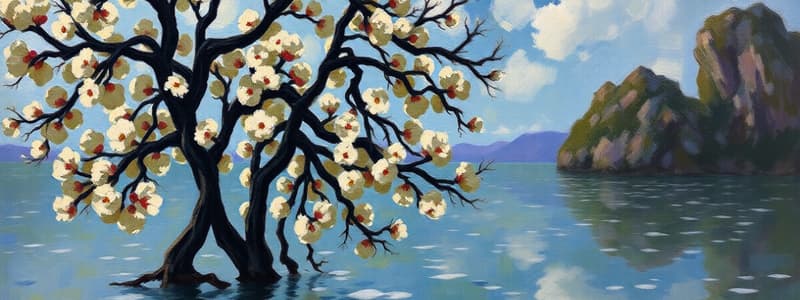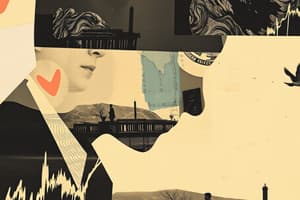Podcast
Questions and Answers
What is the purpose of skimming a text?
What is the purpose of skimming a text?
- To quickly identify the main idea (correct)
- To analyze the content in detail
- To enjoy the narrative style
- To memorize specific data
Which of the following best describes extensive reading?
Which of the following best describes extensive reading?
- Reading with a focus on comprehension exercises
- Reading only academic texts for research purposes
- Free reading of materials that are not too difficult (correct)
- Reading texts that are too challenging for the reader
What defines manga in literature?
What defines manga in literature?
- Japanese comics or graphic novels published originally in Japan (correct)
- A type of graphic novel with Western influences
- A combination of music and literary texts
- A narrative told in novel format with illustrations
Which genre uses a combination of book, movie/video, and internet website?
Which genre uses a combination of book, movie/video, and internet website?
What does the term 'non-fiction' represent in literature?
What does the term 'non-fiction' represent in literature?
Which of the following is NOT a characteristic of flash fiction?
Which of the following is NOT a characteristic of flash fiction?
Which genre is characterized by imaginative concepts and speculative fiction?
Which genre is characterized by imaginative concepts and speculative fiction?
What distinguishes a blog from other writing formats?
What distinguishes a blog from other writing formats?
Which of the following manga categories is specifically aimed at children?
Which of the following manga categories is specifically aimed at children?
Which aspect is NOT typically analyzed in a graphic novel's visual storytelling?
Which aspect is NOT typically analyzed in a graphic novel's visual storytelling?
Flashcards are hidden until you start studying
Study Notes
Reading Approach
- Reading can help students learn about different cultures
- Inferencing, guessing, and predicting are important reading skills
Skimming
- The main idea of a text can be quickly identified
- Skimming is three to four times faster than regular reading
- Headings, summaries, and other organizers can help with skimming
Scanning
- Scanning is reading quickly to get a summary
- Scanning involves moving the eyes quickly down the page to locate certain words and phrases
- Dates, names, and places are commonly scanned for
Extensive Reading
- Extensive reading is an approach to language learning
- Also called Free Voluntary Reading
- Reading material should not be too difficult for the reader
21st Century Literature
- Refers to new literary works created in the last decade
Major Literary Genres
- Poetry: Imaginative awareness of experience expressed through language
- Drama: Composition in prose or verse representing a story involving conflict, intended to be acted on stage
- Fiction: Literature created from the imagination, not presented as fact
- Non-Fiction: Based on facts and the author’s opinion about a subject
21st Century Literature Genres
- Illustrated Novel: Uses images to tell a story
- Examples: The Invention of Hugo Cabret and The Arrival
- Digi-Fiction: Uses a combination of three media: book, movie/video, and internet website
- Examples: Skeleton Creek and Level 26
- Graphic Novels: Narratives told in comic-strip formats
- Examples: Archie Comics and The Death of Captain Marvel
- Manga: Japanese word for comics, used as a term for all comic books and graphic novels originally published in Japan
- Examples:
- Shonen: (Boys) Naruto, Bleach, One Piece
- Shojo: (Girls) Sailormoon
- Seinen: (Men) Akira
- Josei: (Women) Loveless, Paradise Kiss
- Kodomo: (Children) Doraemon, Hello Kitty
- Examples:
- Doodle Fiction: Uses doodle writing and drawings
- Examples: Diary of a Wimpy Kid and Timmy Failure
- Text Talk Novel: Told almost entirely in dialogue
- Example: Vince and Kath
- Chick Lit: Often lighthearted and addresses issues of modern womanhood
- Examples: The Night Before Christmas and It Started With A Kiss
- Flash Fiction: Extremely brief stories that still offer plot and character development
- Examples: For Sale: baby socks, never worn and Longed for him.Got him, Shit.
- Common characteristics:
- Brevity
- Complete plot
- Surprising ending
- Creative Nonfiction: Uses literary techniques to tell factually accurate narratives
- Examples: 1000 Gifts and Wind, Sand, and Stars
- Science Fiction: Speculative fiction dealing with imaginative concepts
- Examples: Mockingjay and Kingdom of Ash
- Blog: Website containing articles called posts that are updated regularly
- Hyper Poetry: Digital poetry that uses links and hypertext mark-up
Analyzing Graphic Novels
- Art style
- Panel composition
- Color and shading
- Character design
- Backgrounds and settings
- Symbolism and metaphors
- Sequential flow
Conventional Literary Genres
- Structure: Follow traditional narrative structures and established forms
- Themes: Centered around classic themes like heroism, morality, and the human condition
- Characterization: Clear distinction between protagonists and antagonists
- Style: Adhere to specific genre conventions
Studying That Suits You
Use AI to generate personalized quizzes and flashcards to suit your learning preferences.




